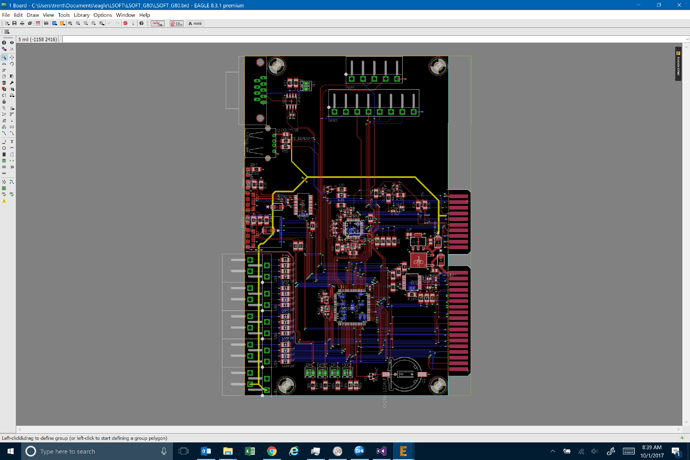We demonstrate our new Universal Compute Module’s Breakout Board. This makes adding our UCM’s to your design even easier. It also opens the door to many different customizing options. It also makes adding a displays to your design simple.
#options 
Gus, very impressive. The flexibility is a game changer.
but wait…there’s more…
Only one hard question … When?
This will make my job much easier. I’ll only need to build one microcontroller board for our modular system, instead of X different boards.
We’re (the community) will need a SODIMM compatible G30 / G80 / G120 chipset at roughly the same price point as SOC… of course, additional options to bridge some of the gaps between the series would be nice too, to make the lineup more granular. Shouldn’t be a problem right? As you get TinyCLR “more done” porting to various new configurations shouldn’t be overly difficult.
Otherwise it’ll likely be more cost effective for us to have X different board designs with direct SOC components mounted. SODIMM sockets cost a bit (a little shy of $4 in low quantities), and are somewhat fragile on assembly. That can add up. I once broke a pin off of a SODIMM socket just fat fingering the removal from the reel for a manual stencil placement. Scrapped $4 bucks in parts in 1 second with a hook of the pin on the plastic… 
For certain applications that’ll be required anyway since vibration is always a concern, SoM will require each board be designed differently; but easier to assemble than SoC.
Plus, either way, China can’t steal the designs. Can have the boards mostly populated and then easily and quickly assemble the rest “back home” … (Main reason we do our own assembly in house, get boards made over in China but they have no schematics or bill of materials to go off of to fabricate their own complete design.)
What is the established (or has it been established yet) max footprint of the UCM socketed designs?
Can we safely rely on the pinout of the G400 SODIMM at this time for forward compatibility?
G400 is certainly Universal Standard compatible. Full documentation, and some amazing lineup, to follow.
I am glad you and others are seeing the value in new products/technologies.
Oh this fits what I want to do like a perfectly crafted glove, dude. I’m really excited.
Trent, your posts are like premium content.
Thank you.
Thanks Terrence, although I’m just spewing out the thoughts on the top of my head. 
Every company has to work to find their niche and their purpose. Gus and co’s vision for teaching folks how to Make Things, involvement in the advancement of the art, and willingness to take on hard tasks (such as picking up where MS dropped the ball) is a good thing for everyone. They simultaneously support the Maker community as well as building something which can serve as the backbone of production for the commercial developers and manufacturers.
The “making my life easier” part above is no-nonsense honesty. I’m building a line of modular industrial control / automation modules which (hopefully), when they are released, will serve as another stepping stone for folks taking the next great leap and help further bridge the gap between hobbyist and commercial fabricator. My work stands on the shoulders of Gus’s vision - to open embedded development to the world at large, by allowing the millions of .NET programmers out there to easily “make things happen in the real world.”
Going low level is no easy task. Devouring datasheets to write drivers can be devilishly complicated and extraordinarily time consuming, and the learning curve for good discreet circuit design and production feels like one is scaling Mount Everest, at times. 
So my company is working to create a line of production ready, plug & play components which go beyond the dev board, learning, and breadboarding phase. Snap a (GHI based) MCU module and whatever sensor or control modules you want in to a backplane and start making things happen. Want a 16 zone temperature sensing module for an HVAC control system? Got you covered. Need to build a security system? Plug in a specialized GPIO extender module in to the backplane, and start writing code.
These specialized drivers are being built so that the programmer doesn’t have to spend time learning individual discreet IC’s; they can just sit down and write stuff like
modules(“TempSensors”).Zone1.Setpoint = 22.2;
(and when the setpoint is reached, an consumed event triggers)
or
modules(“RelayModule1”).Relay6.Enable;
and a 15 amp branch circuit activates, or whatever.
To this end, the steps GHI is taking towards universal standards on the modules is, indeed, incredibly exciting as I continue to build out on my company’s control module drivers and hardware.
It means I can spend less time designing these;
And more time changing datasheets in to functional modules and accompanying drivers, which are easily programmed with .NET, and making real world products to release in the coming months. There’s hundreds of various sensor modules, relay control modules, stepper and servo drivers, and so on I want my company to produce in .NET; and open standards are vastly important to seeing this dream come to fruition.
So yes, I am indeed very pleased with the direction GHI is moving.
I was wondering what you were working on. I can’t wait to see your catalog of offerings.
Should be quite a bit coming out next spring.
Right now I’m frantically trying to finish office remodeling, getting a new dedicated electronics lab pieced together so I have more room to work. ![]()


